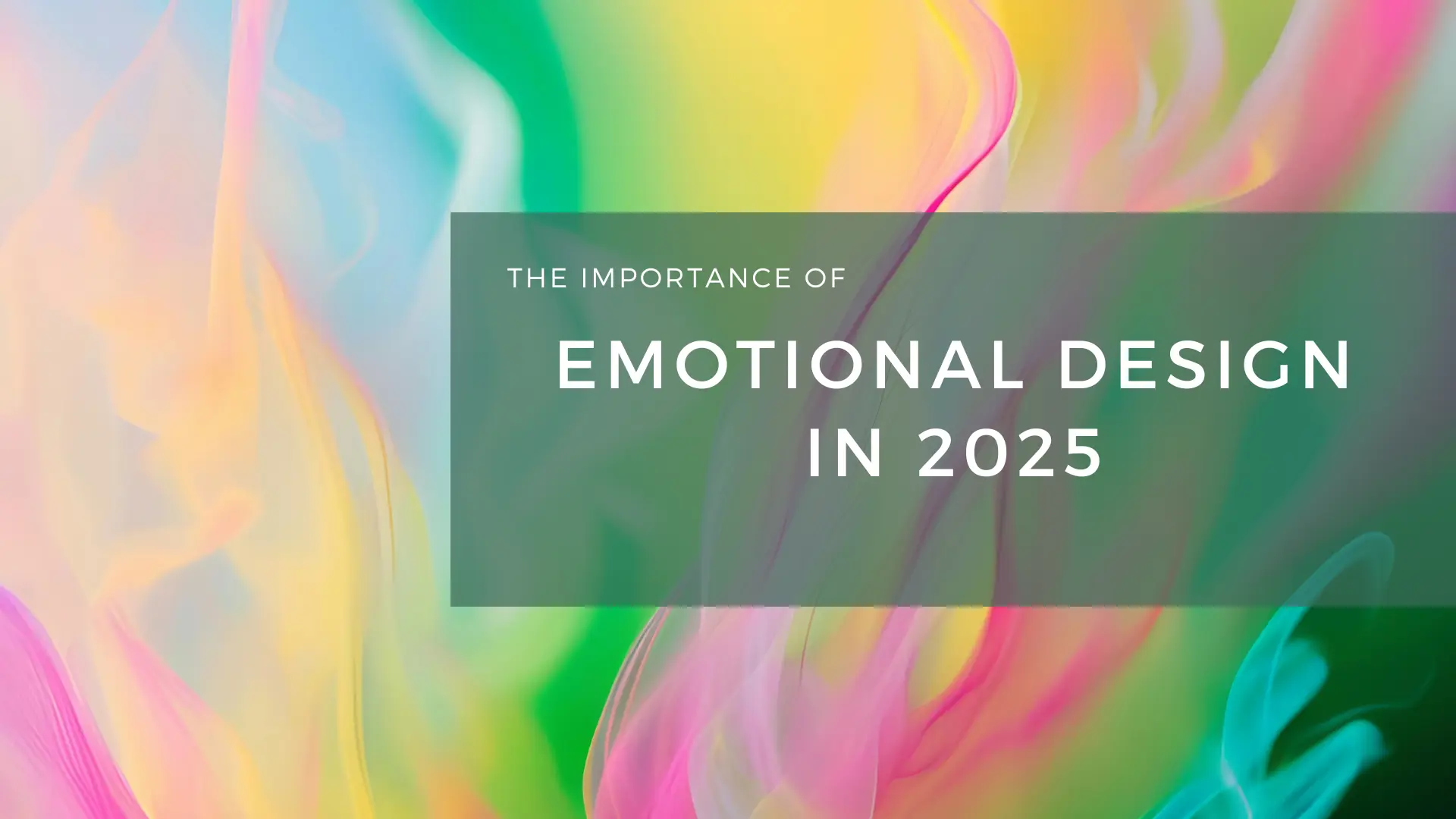Beyond Aesthetics: Unveiling The Importance of Emotional Design in 2025
In 2025, the world finds itself navigating an era of unprecedented technological sophistication. From AI-driven interfaces too immersive virtual experiences, innovation has become seamlessly woven into the fabric of our daily lives. Yet, amidst this whirlwind of progress, a quiet revolution is reshaping the way we interact with the products and environments around us—emotional design.
No longer is a sleek aesthetic or intuitive functionality enough to captivate modern audiences. Rather, the spotlight is shifting toward creating experiences that resonate deeply, spark joy, and foster meaningful connections. Emotional design is no longer a luxury; it’s the unspoken language of engagement, loyalty, and trust in this hyper-connected age.But why does it matter so much now? And how does it redefine the future of design across industries? Let’s explore the critical role emotional design plays at the intersection of innovation and humanity in 2025.
Table of Contents
- Embracing Emotional Design as the Heartbeat of User Experience
- Crafting Human-Centric Interfaces That Resonate with Empathy
- The Role of AI and Personalization in Shaping Emotional Connections
- Balancing Aesthetics and Functionality for Lasting Impact
- Building Trust Through Emotionally Intelligent design Practices
- Design Strategies to Foster Meaningful Digital Relationships
- Q&A
- Future Outlook
Embracing Emotional Design as the Heartbeat of User Experience
- Anticipation & Delight: Adding surprises, like gamified rewards, keeps users emotionally invested.
- Empathy in Design: Accessibility and inclusive features cater to diverse emotional and functional needs.
- Trust-Building: Consistent design patterns and a polished aesthetic evoke confidence in the platform.
| Emotion | Design Technique |
|---|---|
| Happiness | Luminous colors, smooth animations |
| Trust | Clean layouts, familiar navigation |
| Excitement | Dynamic transitions, bold typography |
Crafting Human-Centric Interfaces That Resonate with Empathy
To achieve this, designers can focus on core elements that resonate emotionally with users:
- Contextual Adaptation: Interfaces should adjust dynamically to user behavior, offering relevant suggestions and support at the right moment.
- Minimal Cognitive Load: Streamline interactions to make every action intuitive, reducing frustration and decision fatigue.
- Micro-Moments of Joy: Integrate subtle animations or uplifting messages to surprise and delight users.
Here’s how these principles might play out:
| Scenario | Empathy-Driven feature |
|---|---|
| Struggling with Productivity | AI-powered reminders delivered in an encouraging, conversational tone |
| Navigating Anxiety | Calm visual cues with guided breathing exercises in-app |
| Learning a Skill | Personalized milestones and supportive feedback for achievements |
The Role of AI and Personalization in Shaping Emotional Connections
Brands leveraging AI-driven personalization are also crafting storytelling experiences that adapt in real-time. Imagine a fashion retailer suggesting an outfit based on the weather in your location or a wellness app adjusting motivational messages to your current mood. Below is an example of how AI personalization impacts user engagement:
| Feature | Emotion Addressed | User Response |
|---|---|---|
| AI Chatbot Support | Stress Relief | Customer Loyalty |
| Personalized Recommendations | Excitement | Increased Engagement |
| Real-Time Storytelling | Nostalgia | Stronger Emotional Bonds |
- adaptability: AI learns and evolves based on user input for ever-improving results.
- Inclusivity: Personalized interfaces cater to diverse emotional needs.
- Proactivity: Anticipating user desires before they express them.
Balancing Aesthetics and Functionality for Lasting Impact
Striking the perfect balance between visual appeal and usability is the cornerstone of emotional design in 2025. While breathtaking aesthetics can captivate users instantly, functionality ensures that the experience remains valuable and enduring. Designers are increasingly blending art and engineering, leveraging smooth transitions, intuitive layouts, and adaptive elements. Thoughtfully designed interfaces are no longer just tools—they’re immersive experiences that evoke human emotions like joy, trust, and belonging. From micro-interactions that make navigating a website delightful to tactile product designs that feel effortlessly natural, every detail contributes to a harmonious experience.
- Fluid animations: encourage emotional flow without overwhelming users.
- Accessibility-first design: Ensures inclusivity while maintaining beauty.
- Compact palettes: Convey mood while simplifying visual dialog.
The integration of aesthetics and functionality isn’t just about aligning form and function—it’s about predicting human needs and emotions. This year, designers are using data-driven empathy and emerging technologies like AI-generated insights to craft designs that anticipate user behaviors. Consider the rising prominence of wearable tech: its success relies not only on impressive features but also on how it feels against the skin and responds effortlessly to commands. Below is a quick snapshot of design elements that effectively merge emotional depth with practical use:
| Design Element | Purpose |
|---|---|
| Gradient color schemes | Convey warmth and dynamism |
| Smooth navigation bars | Enhance usability |
| Scalable typography | Accommodate varied screen sizes |
Building Trust Through Emotionally Intelligent Design practices
- Empathy-driven elements: Consider designs that respond to user feedback with warmth and care.
- Tone and voice: Build trust with copy that sounds human and approachable, rather of robotic.
- Personalization: Simple touches like greeting users by name can create a sense of connection.
| Practice | Outcome |
|---|---|
| Responsive Animations | Reinforces user satisfaction |
| Empathetic Error Messages | Builds user trust |
| Humanistic Chatbot Tones | encourages repeat engagement |
Design Strategies to Foster meaningful Digital Relationships
Another strategy is encouraging community-centric environments where collaboration and shared interests thrive. Features like group video chats, forums, or even virtual events can help create shared digital experiences. Highlight participation tools like polls or custom badges to provide users with a sense of identity and contribution within the community. Here’s a comparison table showcasing popular features for fostering meaningful user interaction:
| Feature | Purpose |
|---|---|
| Custom Emoticons | Add a personal flair to communication |
| Weekly Challenges | Encourage collaboration and goal-setting |
| Interactive Story Highlights | showcase shared milestones |
Q&A
The Importance of Emotional Design in 2025: 5 Key Q&As
Q1: What is emotional design, and why is it so relevant in 2025?
Emotional design refers to crafting products, interfaces, and experiences that evoke positive feelings, foster connections, and enhance deeper engagement with users. In 2025, where technology seamlessly integrates into daily life, emotional design has become critical for differentiating brands, creating customer loyalty, and humanizing digital interactions in an increasingly automated world. It’s no longer just about functionality—it’s about how users feel while using a product.
Q2: How is emotional design shaping user experiences today?
In 2025,emotional design is redefining user experiences by focusing on storytelling, personalization, and intuitive design. For instance, AI-powered tools now adapt visually and emotionally based on user moods, while brands use rich, sensory-based interfaces to evoke joy, trust, or calm. Emotional design helps break through the noise by offering experiences that resonate on an authentic, human level.
Q3: what industries are leading the charge in emotional design innovation?
Industries like healthcare, gaming, and e-commerce have become early pioneers. Healthcare applications use empathetic, calming visual interfaces and AI-driven emotional support to reduce patient anxiety. Gaming, on the other hand, leverages immersive storylines and ambient music to create emotionally gripping worlds. Meanwhile, e-commerce brands focus on fostering joy and trust through hyper-personalized recommendations and user-friendly interactions designed to eliminate frustration.
Q4: What challenges do designers face in achieving emotional resonance?
Despite its appeal, emotional design in 2025 faces challenges like cultural diversity, ethical boundaries, and emotional sensitivity. Understanding what resonates universally versus what requires tailoring is complex, as design elements carry different meanings across cultures. Additionally, the balance between emotional engagement and manipulation remains a thin line—a misstep could lead to user distrust rather then delight.
Q5: How can designers achieve emotional balance without overwhelming users?
Designers in 2025 are turning to data-driven empathy and human-centric approaches to strike the right balance. They combine user analytics with open-ended, qualitative feedback to understand how interactions feel at different points. by keeping designs simple yet impactful and incorporating “breathing room” in interfaces, they ensure that emotional engagement enhances rather than overloads the user experience. After all, subtlety often speaks louder than excess.
—
The practice of emotional design continues to evolve, and by 2025, it’s clear: the future of innovation belongs to those who understand that feelings shape every interaction.
Future Outlook
As we step further into 2025, the importance of emotional design grows ever clearer, shaping not just the objects we use but the connections we create and the ways we experience the world around us. It’s no longer enough to design for functionality alone. The products, interfaces, and spaces of tomorrow must inspire, comfort, and delight—meeting the unspoken needs of the human spirit. Emotional design is the bridge between innovation and empathy, a gentle reminder that the most meaningful experiences are the ones that make us feel something. And as technology advances and creativity flourishes, one thing is certain: design that resonates emotionally will remain at the heart of our progress.


